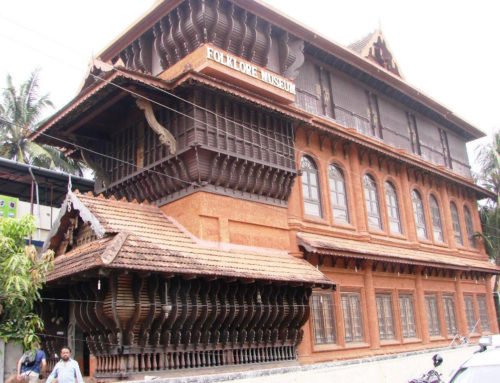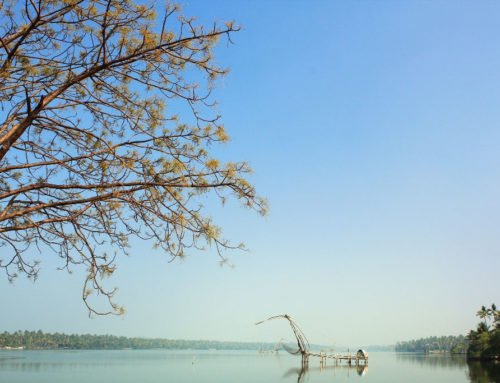Overview
- Features: Land based cantilevered Chinese fishing nets
- Opening Times: Dawn to dusk, daily
- Best Time to Visit: Evening before sunset
- Duration: 20 to 30 minutes
- Travelled By: Auto rickshaw
- Cost: Free
- Address: Fort Kochi, Kochi, Kerala, India
- Type: Structure
Author Reviews[display_rating_item_results rating_form_id=”2″ rating_entry_ids=”1″ show_category_filter=”false” show_options=”true” result_type=”star_rating” preserve_max_rating=”true” show_title=”false” show_count=”false” ]
Total Rating: [display_rating_result rating_form_id=”2″ show_count=”false” show_rich_snippets=true] [accordions load=”1″] [accordion title=”User Reviews” last] [display_rating_item_results rating_form_id=”5″ show_options=”true” result_type=”star_rating” preserve_max_rating=”true” show_title=”false” show_count=”true” show_rich_snippets=true] [/accordion] [accordion title=”Add Review”][display_rating_form show_email_input=”true” show_comment_textarea=”true” show_name_input=”true” rating_form_id=”5″] [/accordion] [/accordions]
Summary
At the tip of Fort Cochin sit the unofficial emblems of Kerala’s backwaters: cantilevered Chinese fishing nets. They have become a very popular tourist attraction in Fort Kochi. These are not unique to Kochi, but are perhaps uniquely accessible to the short-stay visitor.
Chinese Fishing Nets @ Fort Kochi
At the tip of Fort Cochin sit the unofficial emblems of Kerala’s backwaters: cantilevered Chinese fishing nets. This is the only location in the entire world outside of China where such fishing nets can be seen in use. These are not unique to Kochi, but are perhaps uniquely accessible to the short-stay visitor. A large number of these nets can be seen scattered throughout a whole stretch of the coast along Fort Kochi and Vypeen.
First erected between 1350 and 1450, these cantilevered fishing nets indicate trade links with China; they are a legacy of traders from the 1400 A.D. court of the infamous Chinese ruler Kublai Khan. It was earlier thought that the nets might have been introduced by the Chinese explorer Zheng He. Recent research shows that these Chinese fishing nets were introduced by Portuguese Casado settlers from Macau.
[singlepic id=1206 w=720 h=560 float=center]
These iconic batwing Chinese fishing nets stand on the shores of the north fort area, silhouetted against the lapping waters of one of the world’s finest natural harbours, a wide bay interrupted by narrow spits of land and coconut-covered islands.
[singlepic id=1202 w=720 h=560 float=center]
These enormous, spider-like contraptions hold out horizontal nets of 20 m or more across. Each structure is at least 10 m high and comprises a cantilever with an outstretched net suspended over the sea and large stones suspended from ropes as counterweights at the other end. Each installation requires at least four people to operate their counterweights at high tide.
Rocks, each 30 cm or so in diameter are suspended from ropes of different lengths. As the net is raised, some of the rocks one-by-one come to rest on a platform thereby keeping everything in balance. The system is sufficiently balanced that the weight of a man walking along the main beam is sufficient to cause the net to descend into the sea. The net is left for a short time, possibly just a few minutes, before it is raised by pulling on ropes. The catch is usually modest: a few fish and crustaceans — these may be sold to passers by within minutes.
[singlepic id=1204 w=720 h=560 float=center]
Even today, many local fishermen use these enormous nets in their fishing endeavors. Unfortunately, modern fishing techniques are making these labour-intensive methods less and less profitable. Nevertheless, the Chinese fishing nets have become a very popular tourist attraction in Fort Kochi and continue primarily for this reason. Their size and elegant construction makes for a great photo op and the slow rhythm of their operation is quite interesting to watch. The fishermen actually allow tourists to operate the fishing nets for a small donation which can be an adventure. In addition, catches can be purchased individually and need be taken only a short distance to a street entrepreneur who will cook it into a delicious seafood dish.
[singlepic id=1203 w=720 h=560 float=center]
Behind the Chinese fishing nets are several fishmongers (seafood per kg Rs 200-400), from whom you can buy all kinds of seafood (fish, prawns, scampi, squid, lobster), then take your selection to the nearby row of shacks where the folks there will cook it and serve it to you (cooking is an extra Rs 100 per kg). Bear in mind that the seafood stocked at the fishmongers are bought from the local market rather than caught in the Chinese fishing nets nearby.
Getting to & from the Chinese Fishing Nets
The Chinese fishing nets are located along the seafront of Fort Kochi, between the Fort Kochi bus stand, the boat jetty and the Dutch cemetery. You can get here on foot if you’re nearby otherwise a local bus can drop you at the Fort Kochi bus stand. Alternatively, you can hop into an auto rickshaw; ask him to drop you in front of the Chinese fishing nets.







